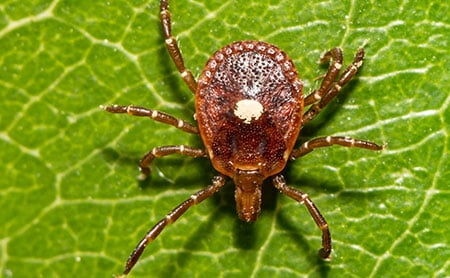What Health Officials Should Know About Alpha-Gal Syndrome
April 30, 2024 | Courtney Youngbar

About Alpha-Gal Syndrome
Alpha-gal syndrome (AGS), sometimes called red meat allergy, is an emerging allergic condition mainly caused by the bite of a lone star tick and is characterized by an IgE–mediated hypersensitivity to alpha-gal. Alpha-gal is a molecule found in non-primate mammals and their by-products (e.g., pork, beef, gelatin, dairy), but not in humans. To prepare for the potential of increasing AGS cases, health officials should consider the need for tick surveillance and control.
When a lone star tick carrying alpha-gal molecules bites a person, the tick can potentially transfer the molecules into the person’s bloodstream. The person's body produces antibodies to fight the alpha-gal, so that the next time a person eats a product containing alpha-gal, like red meat, the alpha-gal triggers an allergic reaction. Fish and poultry products (e.g., turkey, chicken, eggs) do not contain alpha-gal, so people affected by AGS can still consume these products.
Symptoms include hives, itching, stomach upset, and even anaphylaxis. Symptoms generally appear a few hours after consumption of red meat or animal products but have been reported in longer intervals after exposure. Diagnosis of AGS includes allergy skin tests and alpha-gal-specific IgE tests, which are available through commercial laboratories.
A Growing Public Health Threat
From 2010–2022, more than 110,000 suspected cases of AGS were identified in the United States, but current knowledge of where cases occur is limited since AGS is not a nationally notifiable condition. AGS seems to most often occur in the central and southern United States, which corresponds to the distribution of the lone star tick. However, since doctors are not required to report the number of patients with AGS, the true number of affected individuals and locations is unknown.
Unfortunately, no treatment or cure for AGS is currently available. Management of AGS includes the use of antihistamines, epinephrine, and eliminating red meat and other alpha-gal-containing products from the diet. But the key to reducing the impact of AGS is prevention—avoiding tick bites in the first place.
What Health Agencies Can Do
To prepare for increasing cases of AGS, health officials should consider critical infrastructure needs for tick surveillance and control. These include developing risk communication strategies, implementing tick surveillance programs, and providing more resources to promote behavior change among the public to prevent tick bites.
Strategies for surveillance and control of ticks and prevention of tick bites include:
- Educate communities on ways to prevent tickborne diseases. It is essential that outreach and educational materials are available in multiple languages. Tailor education campaigns for populations at greatest risk in your jurisdiction, such as outdoor workers, landscapers, farmworkers, and outdoor enthusiasts.
- Work with companies to provide low-cost education materials and prevention tools, such as insect repellent and tweezers, to workers.
- Consider people’s culture, environment, and English proficiency when developing materials to help people understand information and act on it. For example, naming specific products (e.g., beef, pork, milk) that contain alpha-gal vs. the use of terms like “mammalian or mammal meat.” While correct, this term may be confusing or not known to some people.
- Provide education and support to clinicians and allergists. According to a recent CDC MMWR, there is limited healthcare provider knowledge about AGS. Improving education outreach to providers may help with a quick diagnosis of AGS, improving patient care and outcomes.
- Coordinate with multiple disciplines and agencies to implement a One Health approach and reach a broader audience.
- Connect with CDC Centers of Excellence and local universities pursuing research in tick control to help bridge the gap between academia and public health practice.
- Share AGS data in their jurisdictions with members of CDC’s Rickettsial Zoonoses Branch to better understand national trends. Submit case report forms.
- Share ways people can prevent tick bites as part of Lyme Disease Awareness Month in May.
There is a critical need for public health activities to prevent and control tickborne diseases like community education around tick bite prevention, healthcare provider education for timely diagnosis and allergic condition management, and improved tick surveillance.
Health agencies have an important role in educating and collaborating with local programs, providers, and allergists to develop and implement strategies to help protect people from tickborne diseases.
Key Takeaways
- AGS is a serious, potentially life-threatening allergic condition
- The risk of AGS seems to be highest in the central and southern United States, which corresponds to the distribution of the lone star tick
- Cases are predicted to increase during the coming years as the geographic range of the lone star tick continues to expand
- Doctors are not required to report patients with AGS and there is not national surveillance system for AGS
- No treatment or cure is currently available—prevent tick bites to prevent AGS